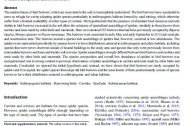Content
The arachnofauna of bird burrows, which are excavated in the soil, is incompletely understood. The bird burrows have a potential to serve as refugia for cavity-adopting spider species particularly in anthropogenic habitats formed by sand mining, which otherwise suffer from a limited availability of other types of cavities.We hypothesized that the presence of abundant food resources and safe shelter in bird burrows excavated in the soil allow the existence of specialized assemblage of spiders, similarly to those known from cavities and nests made by other birds andmammals. Here we examined 353 burrows that had been previously occupied by Riparia riparia, Merops apiaster or Passer montanus. The burrows were examined in earlyMay and early September in 24 Czech sand pits and construction sites. The burrows hosted a species-rich assemblage of spiders that, however, occurred at low abundances. The spiders were represented prevalently by species known to have distributions centered in anthropogenic and urban habitats, including species that were never observed outside of heated buildings in the study area and species that only were previously known from mammalian burrows and loess and karstic soil crevices. Spider assemblages strongly differed between bird burrows and cavities and nests made by other birds and mammals. The species composition and overall low abundance of spiders in bird burrows was unexpected and was in strong contrast to previous observations of spider assemblages in cavities and nests made by other birds and mammals. Concluded, we rejected the initial hypothesis and, instead, we have shown that bird burrows are rarely occupied by spiders and if occupied, the spider species that adopt old bird burrows and the nests inside of them predominantly consist of species known to have their distribution centered to anthropogenic and urban habitats.



